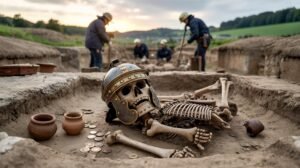Ancient Roman Soldiers’ Mass Grave Unearthed in Austria Discovery


Have you ever wondered what secrets lie beneath our feet? Sometimes, history literally resurfaces, offering rare glimpses into the lives and deaths of those who came before us. That’s exactly what happened recently in Austria, where archaeologists made a chilling yet fascinating discovery—a mass grave of Roman soldiers dating back over 1,500 years.
A Shocking Find Beneath Austrian Soil
Imagine going about your day and suddenly coming across human remains—it’s not something you’d expect, right? But that’s what Austrian workers stumbled upon when they unearthed fractured bones during a routine construction project. What began as a regular dig quickly turned into an archaeological hotspot.
Soon, experts realized they weren’t just looking at a single burial. This was a mass grave, possibly from the late Roman Empire, containing the remains of at least 50 individuals. Based on early analysis, many were likely Roman soldiers—young men who might have died during a brutal and possibly chaotic conflict.
Who Were These Soldiers?
According to archaeologists at the Austrian Academy of Sciences (ÖAW), many of the skeletons showed signs of violent injuries. Broken bones, cut marks, and skull fractures suggest that these men didn’t die of natural causes—they were likely victims of battle or a massacre.
Most of the remains belonged to men aged between 20 and 35, a common age range for soldiers. Some had potential ties to the Roman military based on the location, burial style, and nearby artifacts discovered alongside them.
So, what happened to them?
While experts are still piecing together the full story, clues suggest a violent event took place during the waning years of the Roman Empire—possibly during the 4th or 5th century CE. It was a time of turmoil, invasions, and collapse throughout the empire, particularly in regions like present-day Austria.
The cause of death for many appears to be combat-related. These soldiers may have either fallen in battle or been executed afterward. It’s even possible they were caught in a surprise ambush. Until more is uncovered, the exact reason remains a gripping historical mystery.
Austrians Dig Into Their Roman Past
You might not think of modern Austria as a Roman stronghold, but it played a significant role in Rome’s expansion across Europe. Back then, the region was part of the Roman province known as Noricum. Roman roads, trade networks, and military posts stretched through the area, all forming part of the empire’s northern borders.
This new discovery adds to a growing list of archaeological findings in Austria that shine a light on just how far-reaching the Roman presence really was.
Why Is This Discovery Important?
Besides the sheer scale of the grave, what makes it remarkable is the potential it holds. Each skeleton tells a story—not just about death, but also about culture, health, warfare, and even the diet of ancient Roman soldiers. Scientists can now study:
- Bone injuries to understand how the soldiers died.
- DNA samples to trace where they came from.
- Teeth and bones for clues about their age, health, and diet.
It’s like a giant puzzle, and every piece helps researchers get one step closer to understanding what life—and death—was like on the fringes of the Roman Empire.
How Do Archaeologists Know All This?
If you’re wondering how experts can learn so much from bones alone, it’s actually a mix of science and detective work.
For example, seeing multiple bones with similar cut marks or damage can point to a shared cause of death—like battle wounds or mass execution. The position of the skeletons also matters. If they were buried hastily and without ceremony, it might indicate a battlefield burial rather than a peaceful one.
Things like pottery shards, remnants of clothing, or even ancient coins found nearby help date the site and offer clues about the people buried there.
The Human Side of History
Sometimes, it’s easy to forget that history is about people, not just events. These soldiers weren’t nameless figures in a textbook—they were real individuals with hopes, fears, and families. Maybe they were stationed far from home. Perhaps they never expected their final resting place would be rediscovered centuries later by future generations.
This discovery serves as a touching reminder of how connected we are to those who came before us. After all, their stories have now become part of our shared human history.
A Chance to Reflect
What would these men think if they knew their remains would one day spark global curiosity? Would they be proud that people still study the Roman legacy? Would they hope we learn something from their fate?
These are the questions that keep historians and archaeologists driven—despite the time, effort, and mystery involved in piecing history together.
What Comes Next?
The excavation team is continuing their work, meticulously cataloging bones, collecting samples, and analyzing the site. It’s a slow and careful process, but the outcome could reshape how we understand Rome’s fall in Central Europe.
In the coming months, we can expect more insights as researchers uncover further details about who these individuals were, where they came from, and how they died.
Why This Matters Today
Understanding the past helps us make sense of the present. Finding a mass grave of Roman soldiers in Austria isn’t just about history—it’s about identity, migration, warfare, and even modern heritage.
As more people show interest in archaeology through documentaries, books, and even social media, discoveries like these help keep history alive—and incredibly relevant.
Final Thoughts
The mass grave found in Austria is more than just a pile of ancient bones—it’s a time capsule from the era of Roman soldiers. It brings their untold stories into the light and opens the door for fresh conversations about the collapse of empires, the nature of war, and our ties to history.
In a way, these Roman soldiers—lost in time—are finally having their stories heard.
So what do you think? Does learning about these long-lost soldiers change how you see history? We’d love to hear your thoughts in the comments below.
And if you’re hungry for more archaeological finds and ancient mysteries, be sure to check back for updates as this story continues to unfold.


